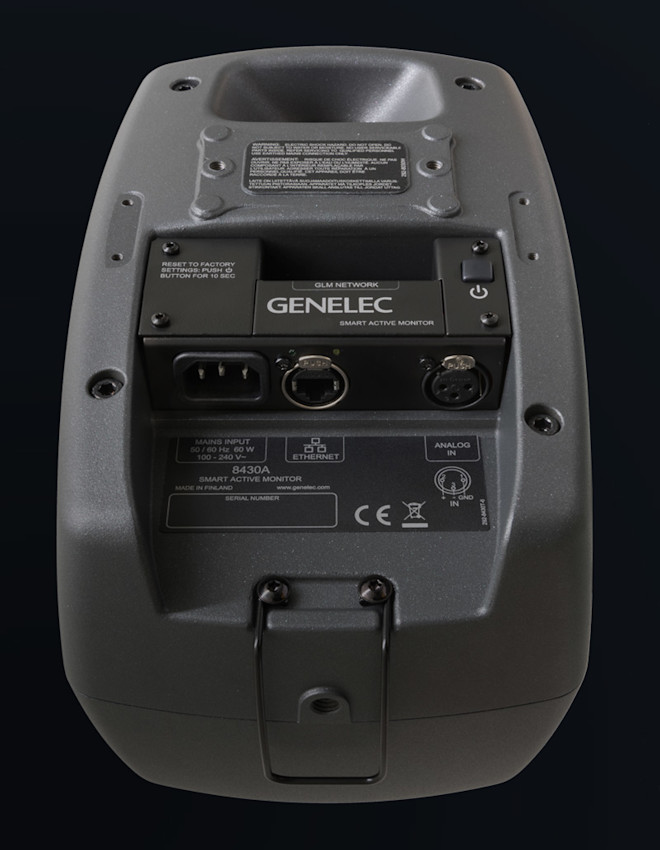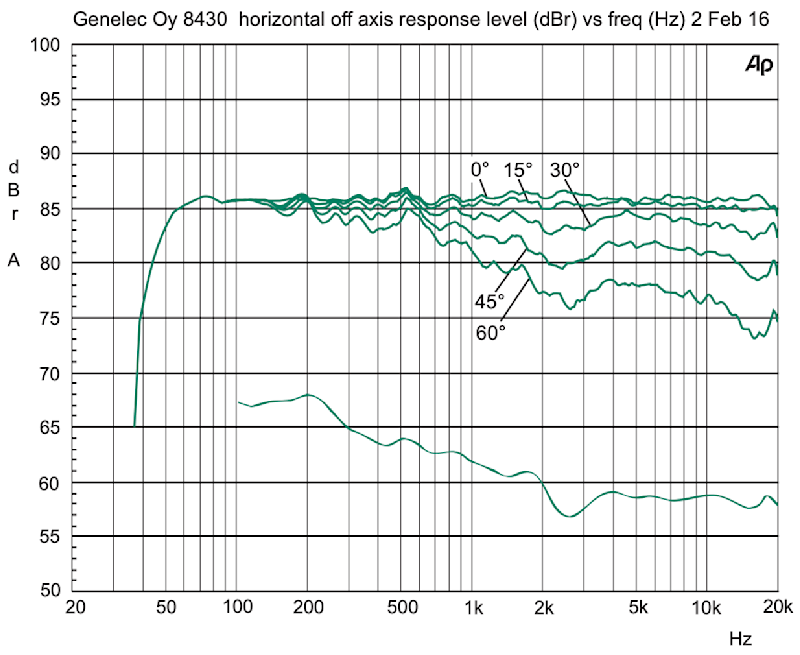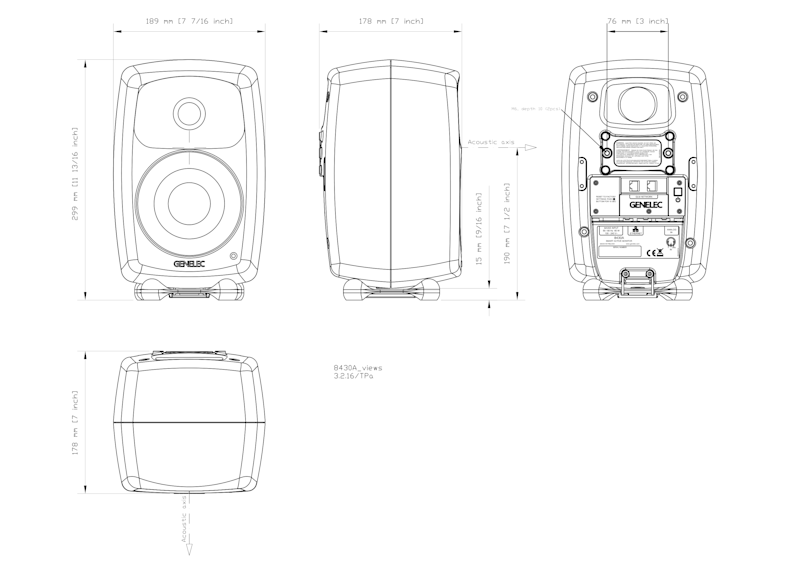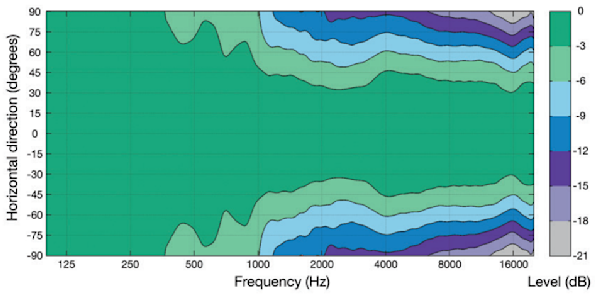Der 8430A ist der weltweit erste AoIP-Studiomonitor, mit dem sich die Leistung eines Monitors in Referenzqualität direkt in Ihren IP-Workflow integrieren lässt.
Der 8430A wurde zwischen 2016 und 2023 produziert.
Der 8430A ist der weltweit erste AoIP-Studiomonitor, mit dem sich die Leistung eines Monitors in Referenzqualität direkt in Ihren IP-Workflow integrieren lässt.
Der 8430A wurde zwischen 2016 und 2023 produziert.
Audio-over-IP (AoIP)

Smart Active Monitor (SAM™)-Systeme

SPL
104 dB

Frequenzgang
45 Hz - 23 kHz (-6 dB)

Abmessungen
H 299 x W 189 x D 178 mm, mit Iso-Pod™ (Anzeige in Inch)
Audio-over-IP gewinnt zunehmend an Bedeutung.
Die Konnektivität des 8430A ermöglicht das direkte Abhören von AoIP-Streams mit der Präzision und Klarheit, die Audioprofis von Genelec gewohnt sind. Der 8430A basiert auf dem Ravenna IP-Protokoll und bietet AES67-Unterstützung für vollständige Kompatibilität. Er eignet sich damit ideal für die heutige moderne Produktionsumgebung.
Als vollwertiger Smart Active Monitor lässt sich der 8430A mit unserer GLM-Kalibrierungssoftware einmessen und steuern, um Ihre IP-basierte Abhöre für Ihre Hörumgebung zu optimieren. Das bedeutet, dass Sie sich immer darauf verlassen können, dass Ihre Mischungen sich optimal übertragen, selbst wenn Sie beispielsweise in schwierigen Broadcast-Umgebungen mit nur rudimentärer akustischer Behandlung arbeiten.
Genelec 8430A IP SAM™ Studio Monitor was awarded a TEC (Technical Excellence and Creativity) Award 2017 in the category of Studio Monitor Technology.
Source: https://www.namm.org/thenammshow/2017/articles/32nd-annual-tec-award-winners

104 dB

50 W Bass (Class D) + 50 W Treble (Class D)

45 Hz - 23 kHz ("-6 dB")

± 1.5 dB (58 Hz - 20 kHz)

⌀ 130 mm Bass + ⌀ 19 mm Treble (Anzeige in Inch)

H 299 x W 189 x D 178 mm, mit Iso-Pod™ (Anzeige in Inch)

5.5 kg / 12.1 lb

1 x XLR Analog Input
1 x RJ45 AES67 Input
2 x RJ45 Control
Der 8430A ist der weltweit erste AoIP-Studiomonitor, mit dem sich die Leistung eines Monitors in Referenzqualität direkt in Ihren IP-Workflow integrieren lässt.
Der 8430A wurde zwischen 2016 und 2023 produziert.
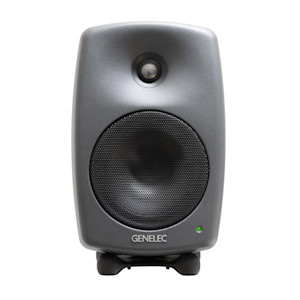
58 Hz - 20 kHz (± 1.5 dB)
Low cutoff -6dB
45 Hz
High cutoff -6dB
23 kHz
Peak SPL Maximum peak acoustic output per pair, 1 m distance with music material.
≥110 dB
Kurzzeitiger max. SPL Maximum short term sine wave acoustic output on axis in half space, averaged from 100 Hz to 3 kHz.
≥104 dB
Max. Langzeit-SPL Maximum long term RMS acoustic output in same conditions with IEC weighted noise (limited by driver unit protection circuit).
≥96 dB
Eigenrauschen Self generated noise level in free field on axis (A-weighted).
≤5 dB SPL
Höhe
285 mm
Höhe mit Iso-Pod
299 mm
Breite
189 mm
Tiefe
178 mm
Gehäusematerial
Die cast aluminium
Gehäusetyp
Reflex port
Treiber-Typ
Cone
Durchmesser
130 mm
Treiber-Typ
Metal dome
Durchmesser
19 mm
The latency at high frequencies from the input to the acoustic output, measured in the analog input:
Extended Phase Linearity in GLM set to OFF
2.3 ms
In Genelec performance graphics, the time of converting the from an electronic input signal to the acoustic output in a Genelec monitor is described by two factors – latency and group delay. The group delay factor can be read in the graphics for a specific frequency. The total frequency-specific input-to-output delay is a sum of the latency and group delay factors. To understand the significance of this total delay, consider that moving a loudspeaker away by 1 meter creates an additional delay of about 3 ms.
50 W Class D
Bass amplifier short term output power.
50 W Class D
Treble amplifier short term output power.
100-240 VAC 50/60Hz
ISS aktiv
≤0.5 W
Leerlauf
≤3 W
Volle Leistung
50 W
Input Analog signal input connector XLR female, balanced 10 kOhm.
Input Audio-over-IP format and input connector:
2 x Control Two CAT5 (RJ45) GLM Network connectors for computer control using the Genelec Loudspeaker Manager (GLM) software.
Audio-over-IP (AoIP)

Smart Active Monitor (SAM™)-Systeme

Directivity Control Waveguide (DCW™)-Technologie

Aktive Frequenzweichen

Intelligent Signal Sensing (ISS™)-Technologie

Iso-Pod™ Standfuß

Minimum Diffraction Enclosure (MDE™)-Technologie

Optimierte Verstärker

Schutzschaltungen

Bassreflexport-Design

Vielseitiges Montagezubehör
The advancing adoption of networked audio has been huge, so we've responded by developing both AV loudspeaker and studio solutions that support AoIP streams, with all the precision and clarity that audio professionals have come to rely on from Genelec.
For demanding AV applications, our growing family of Smart IP loudspeaker models support Dante and Dante-compatible AES67 streams. Smart IP employs uncompressed low-latency audio streaming directly into each loudspeaker, with loudspeaker synchronisation to sub-microsecond level for solid acoustic imaging.
For audio professionals using AoIP connectivity, the Genelec 9401A System Management Device enables the smooth integration of Smart Active (SAM) Monitors and Subwoofers into SAM system layouts, from stereo to immersive, using ST2110, AES67 and Ravenna streams as the source – while offering full support for room adaption from our powerful Genelec Loudspeaker Manager (GLM) software.

In den letzten zehn Jahren hat die Erstellung von Medieninhalten weltweit rapide zugenommen, was zu erheblichen Veränderungen in der Art und Weise geführt hat, wie Einrichtungen mit der gestiegenen Arbeitsbelastung umgehen. Mehr denn je findet eine wachsende Zahl von Audioproduktionen in kleineren, engeren Arbeitsumgebungen statt. Dadurch verstärken sich häufig akustische Probleme und die Zuverlässigkeit beim Abhören sinkt. Gleichzeitig muss man sich als Profi auf ein präzises Abhörsystem verlassen können, das den Klang neutral und ohne Verfärbungen wiedergibt.
Aufbauend auf den bewährten elektroakustischen Grundlagen unserer Produkte der Serien 1200, 8000 und 7000 sind die fortschrittlichen SAM-Systeme von Genelec die modernsten und flexibelsten Abhörlösungen von heute. Sie sind ein unverzichtbares Werkzeug für Audioprofis, da sie sich automatisch an die akustische Umgebung anpassen und Pegel, Verzögerungen und Frequenzgang korrigieren können. SAM-Systeme können über das Genelec-eigene Loudspeaker Manager (GLM™)-Netzwerk und die entsprechende Software gesteuert werden, so dass Sie ein äußerst flexibles und zuverlässiges Abhörsystem aufbauen können.
Die GLM-Software ist ein intuitives und leistungsfähiges Monitorsteuerungs-Netzwerksystem, das die Verbindung zu allen SAM-Studiomonitoren und Subwoofern im Netzwerk verwaltet - mehr als 80 Geräte falls notwendig. Sie ermöglicht die Einstellung von Pegeln, Abstandsverzögerungen und eine Anpassung des Frequenzgangs mit dem intelligenten automatischen Kalibrierungsalgorithmus AutoCal™. Alle Parameter und Einstellungen werden in System-Setup-Dateien oder für den Stand Alone-Betrieb in jedem einzelnen Monitor oder Subwoofer gespeichert.
Außerdem können alle akustischen Eigenschaften der SAM-Systeme für verschiedene Arbeitsstile oder Kundenanforderungen optimiert werden. Auch ween Sie zwischen verschiedenen Räumen wechseln, können Sie von der SAM-Technologie profitieren und ein Höchstmaß an Konsistenz beim Monitoring erreichen.
Genelec SAM-Systeme bieten eine umfassend skalierbare, lösungsorientierte, intelligent vernetzte Produktpalette, die analoge und digitale Signale in praktisch jeder Arbeitsumgebung unterstützt.

Mit der Entwicklung der Directivity Control Waveguide (DCW™)-Schallführung verfolgte Genelec 1983 einen revolutionären Ansatz. Sie wurde damals in einem eiförmigen Gehäuse eingesetzt. Über 30 Jahre entwickelt und immer weiter verfeinert, verbessert sie die Leistung von direkt abstrahlenden Mehrwege-Monitoren erheblich.
Die DCW-Technologie formt die abgestrahlte Wellenfront auf kontrollierte Weise und ermöglicht so eine vorhersehbare Anpassung des Abstrahlverhaltens (Dispersion). Um eine gleichmäßige und ausgewogene Richtcharakteristik zu erreichen, wird der Abstrahlwinkel begrenzt, so dass die Streustrahlung reduziert wird. Dies führt zu einer ausgezeichneten Linearität des gesamten Frequenzgangs sowie zu einem gleichmäßigen Leistungsverhalten. Frühe Reflexionen werden minimiert und man erreicht eine breite und kontrollierte Hörzone, mit einer akkuraten Klangwiedergabe auf und außerhalb der Achse.
Geringe Erstreflexionen und eine kontrollierte, konstante Richtwirkung haben einen weiteren wichtigen Vorteil: Die Frequenzbalance des Raumschallfeldes ist im Wesentlichen die gleiche wie die des Direktfeldes der Monitore. Das hat zur Folge, dass die Leistung des Abhörsystems weniger von den raumakustischen Eigenschaften abhängig ist.
Breite und Tiefe des Klangbildes, kritische Komponenten in jeder Hörumgebung, sind nicht nur für das Hören auf der Achse, sondern auch außerhalb der Achse wichtig. Davon profitieren auch anderen Personen im Raum, die nicht im Sweet Spot sitzen, wie es in großen Regieräumen oft der Fall ist.

Elektronische Frequenzweichen ermöglichen die Aufteilung des Audiosignals in einzelne Frequenzbänder, die separat an einzelne Leistungsverstärker geleitet werden können, die dann an spezifische, für ein bestimmtes Frequenzband optimierte Wandler angeschlossen werden.
Aktive Frequenzweichen gibt es sowohl in digitaler als auch in analoger Ausführung. Die digitalen aktiven Frequenzweichen von Genelec beinhalten zusätzliche Signalverarbeitung wie Schutzschaltungen, Verzögerung und Entzerrung.
Analoge aktive Frequenzweichen von Genelec enthalten elektronische Komponenten, die mit niedrigen Signalpegeln betrieben werden, die für die Eingänge von Leistungsverstärkern geeignet sind. Dies steht im Gegensatz zu passiven Frequenzweichen, die mit den hohen Signalpegeln der Endverstärkerausgänge arbeiten und dabei hohe Ströme und in einigen Fällen auch hohe Spannungen verarbeiten müssen.
In einem typischen 2-Wege-System benötigt die aktive Frequenzweiche zwei Leistungsverstärker - einen für den Tieftöner und einen für den Hochtöner.
Die Verwendung des aktiven Ansatzes ermöglicht die Anpassung und Optimierung des Frequenzgangs des gesamten Lautsprechersystems in verschiedenen Raumumgebungen ohne teure externe Equalizer. Das Endergebnis ist ein einfacheres, zuverlässigeres, effizienteres, konsistenteres und präziseres aktives Lautsprechersystem.

Die Anfang 2013 eingeführte Intelligent Signal-Sensing-Technologie von Genelec wurde entwickelt, um sowohl die ErP-Richtlinien der Europäischen Union als auch die umfassenderen Nachhaltigkeitsverpflichtungen des Unternehmens zu erfüllen.
Die Intelligent Signal Sensing, ISS™-Schaltung verfolgt den Signaleingang des Lautsprechers und erkennt, ob er genutzt wird. Wenn der ISS-Schaltkreis über einen bestimmten Zeitraum kein Audiosignal am Eingang findet, versetzt er den Lautsprecher in einen energiesparenden Ruhezustand und der Lautsprecher verbraucht weniger als 0,5 Watt. Wenn ein Eingangssignal erkannt wird, schaltet sich der Lautsprecher sofort wieder ein.
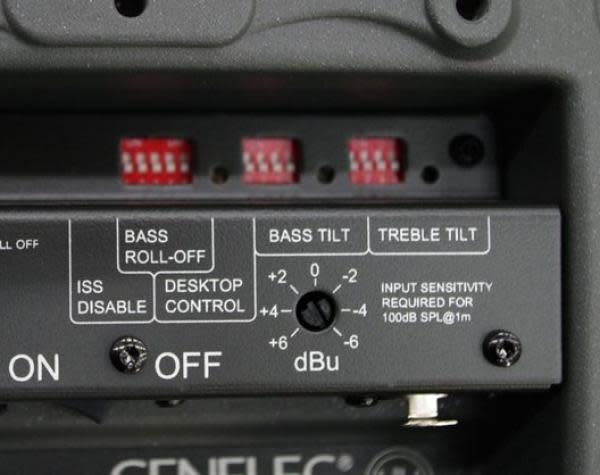
Wenn diese Funktion nicht genutzt werden soll, kann ISS™ deaktiviert werden, indem der DIP-Schalter "ISS Disable" auf der Rückseite in die Position "ON" gestellt wird. In diesem Modus wird der Monitor nur über den Netzschalter ein- und ausgeschaltet.
Beachten Sie, dass der Netzschalter den Monitor immer vollständig ausschaltet.
Nachfolgend finden Sie eine Liste der Bedingungen, die verhindern, dass der Monitor oder Subwoofer in den ISS-Ruhezustand versetzt wird:
Es ist üblich, dass digitale Audioquellen das Clocking-Signal senden, sobald die Quelle eingeschaltet ist. Dies verhindert, dass der Monitor oder Subwoofer in den Ruhezustand übergeht. Es könnte auch ein Rauschen im analogen Eingangssignal vorhanden sein, das den Ruhezustand von ISS verhindert. Um herauszufinden, an welchem Eingang ein Signal anliegt, das das Umschalten in den ISS-Ruhezustand verhindert, entfernen Sie jedes Kabel einzeln und prüfen Sie, ob der ISS-Ruhezustand aktiviert wird.

Obwohl es ratsam ist, freistehenden Lautsprecher auf robusten und stabile Bodenstativen aufzustellen, ist es eine weit verbreitete Lösung, die Lautsprecher direkt auf einen Tisch oder ein Mischpult zu stellen.
Dies führt zu mehreren nachteiligen Nebeneffekten. Die Ausrichtung der Lautsprecherachse auf den Hörer ist nur selten möglich, außerdem übertragen sich unerwünschte mechanische Schwingungen vom Lautsprecher auf die Aufstellfläche, und die Reflexion erster Ordnung an der Arbeitsfläche führt zu Kammfilterung und damit zu Welligkeiten im Frequenzgang.
Um diese sehr häufigen Probleme zu lösen, entwickelte Genelec eine effiziente und sehr praktische Lösung. Wir entwarfen einen Lautsprecherstandfuß namens Iso-Pod™, der am Aluminiumgehäuse befestigt wird. Er hat vier flache Füße und besteht aus einem speziellen gummiartigen Material. Er kann entlang der gewölbten Boden- oder Seitenfläche verschoben werden kann, um eine Neigung des Lautsprechers von ±15° zu ermöglichen.
Die akustische Achse des Lautsprechers kann dann genau auf den Hörer ausgerichtet werden, indem die Neigung des Gehäuses mit dem Iso-Pod eingestellt wird. Die schwingungsisolierenden und dämpfenden Eigenschaften reduzieren Verfärbungen im Mitteltonbereich, die durch unerwünschte, auf die Auflageflächen übertragene Schwingungen entstehen.
Diese innovative Lösung ist ein integraler Bestandteil des Genelec-Lautsprecherdesigns und bietet klare Vorteile in Bezug auf Benutzerfreundlichkeit und Klangqualität.

Ein häufiges Problem bei Standard-Standlautsprechern ist, dass die Unregelmäßigkeiten in der Schallwand zu Beugungen führen und die scharfen Ecken des Lautsprechers als sekundäre Schallquellen wirken.
Um die Linearität des Frequenzgangs und die Leistung freistehender Lautsprechersysteme zu verbessern, hat Genelec ein hochinnovatives Gehäuse entwickelt, das auf die Eigenschaften der Monitortreiber abgestimmt ist und abgerundete Kanten sowie eine sanft gewölbte Front und Seitenwände aufweist. Neben der unübertroffenen Linearität des Frequenzgangs sorgt das Gehäuse für eine hervorragende Abbildung.
Um eine glatte und elegant gewölbte Gehäuseoberfläche zu erreichen und die Außenabmessungen des Gehäuses zu reduzieren, während gleichzeitig das Innenvolumen für einen verbesserten Wirkungsgrad im Tieftonbereich maximiert wird, haben wir ein Gehäuse aus Aluminiumdruckguss entwickelt. Aluminium ist leicht, steif und sehr einfach zu dämpfen, um eine "tote" Struktur zu erhalten. Die Gehäusewände können relativ dünn ausgeführt werden und bieten gleichzeitig eine gute EMV-Abschirmung und eine hervorragende Wärmeableitung für die Endverstärker. Der Druckguss besteht aus zwei Teilen, der Vorder- und der Rückseite, die für eventuelle Wartungsarbeiten leicht zu trennen sind.
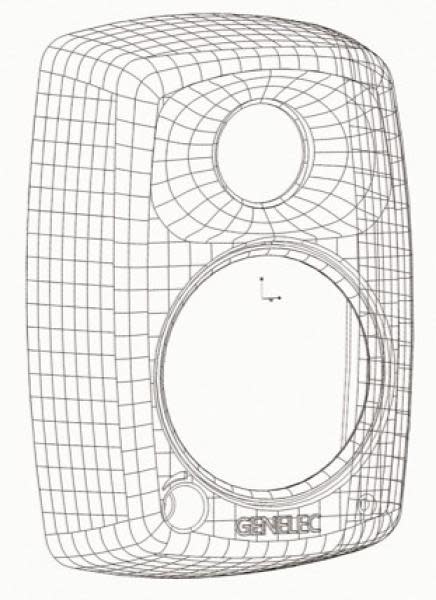
Der DCW-Waveguide wurde in das MDE-Aluminiumgehäuse integriert, um eine bessere Kontrolle über die Richtwirkung des Lautsprechers zu ermöglichen. Grundsätzlich wird die niederfrequente Grenze für eine konstante Richtcharakteristik durch die Größe der Schallführung bestimmt, d. h. je größer die Oberfläche, desto besser die Kontrolle. Mit einer sehr kontrollierten Abstrahlung auf und außerhalb der Achse wird die Hörzone konsistent, was besonders bei Mehrkanal-Anwendungen von größter Bedeutung ist. Die kontrollierte Richtwirkung reduziert auch mögliche Reflexionen erster Ordnung an Oberflächen in der Nähe des Lautsprechers und trägt so zu einer konsistenten Audiowiedergabe in unterschiedlichen akustischen Umgebungen bei. Die gesamte vordere Schallwand ist sanft gewölbt und die akustisch transparenten Schutzgitter fügen sich optisch perfekt in die verschiedenen anderen gewölbten Oberflächen ein.

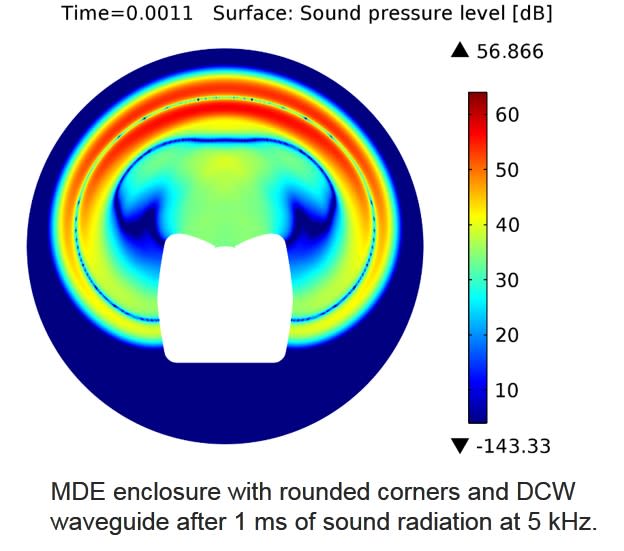

Elektronische Frequenzweichen ermöglichen es, das Audiosignal in einzelne Frequenzbänder aufzuteilen, die separat an einzelne Leistungsverstärker geleitet werden können, die dann an spezielle, für ein bestimmtes Frequenzband optimierte Schallwandler angeschlossen werden.
In einem typischen 2-Wege-Lautsprechersystem benötigt die aktive Frequenzweiche zwei Leistungsverstärker - einen für den Tieftöner und einen für den Hochtöner. Die Leistungsverstärker werden direkt an die Chassis eines Aktivlautsprechers angeschlossen, wodurch die Belastung des Leistungsverstärkers viel einfacher ermittelt werden kann. Jeder treiberspezifische Leistungsverstärker hat nur einen begrenzten Frequenzbereich zu verstärken (der Leistungsverstärker wird nach der aktiven Frequenzweiche platziert), was die Konstruktion noch einfacher macht.
In kritischen Produktionsumgebungen ist es unerlässlich, dass Abhörsysteme jederzeit zuverlässig und voll funktionsfähig arbeiten. Einer der Hauptgründe für den großen Erfolg von Genelec in Rundfunk- und Fernsehumgebungen ist die Zuverlässigkeit unserer Produkte. Ein Schlüsselelement für diese Zuverlässigkeit ist die interne Schutzschaltung, die seit 1978 in allen Produkten enthalten ist.
Die Schutzschaltung verhindert Treiberausfälle, indem sie Signalpegel erkennt und bei plötzlichen Pegelspitzen oder konstant zu hohen Pegeln den Signalpegel automatisch absenkt. Natürlich beeinträchtigt diese Funktion in keiner Weise die Klangqualität der Lautsprecher, wenn sie innerhalb der Spezifikationen arbeiten, sondern verhindert nur, dass zu hohe Eingangssignale den Lautsprecher zerstören.
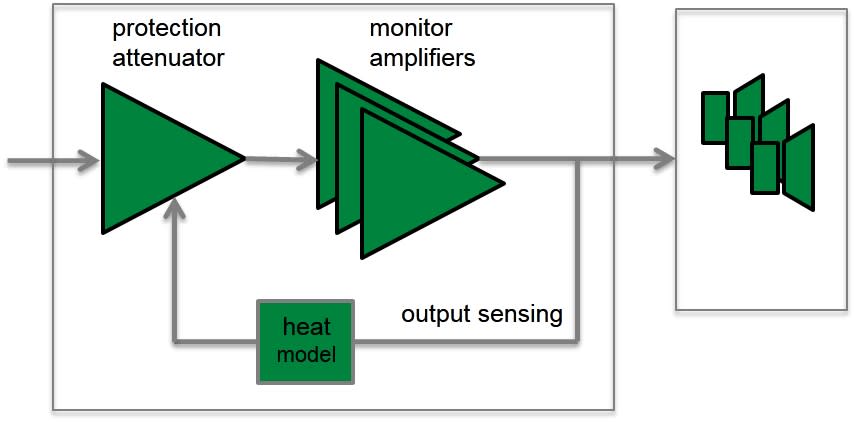

Genelecs Entscheidung für Bassreflex-Gehäuse geht auf das Modell S30 zurück, das erste Genelec-Produkt aus dem Jahr 1978. Die Leistung der Ports wurde im Laufe der Jahre verbessert und verfeinert, um die Basserweiterung und den Schalldruckpegel des Tieftöners zu erhöhen und eine hervorragende Bassartikulation und -definition zu erreichen.
Sowohl der Treiber als auch der Port tragen zur Gesamtabstrahlung eines Reflexgehäuses bei. Der größte Teil der Abstrahlung kommt vom Treiber, aber bei der Resonanzfrequenz des Bassreflexgehäuses ist die Auslenkungsamplitude des Treibers klein und der größte Teil der Abstrahlung kommt aus der Öffnung.
Um die Luftgeschwindigkeit im Rohr zu minimieren, sollte die Querschnittsfläche der Öffnung groß sein. Das wiederum bedeutet, dass das Reflexrohr lang sein muss, was eine ziemliche Herausforderung für das Design darstellt.
Das lange, gebogene Rohr maximiert den Luftstrom, so dass tiefe Bässe ohne Kompression wiedergegeben werden können. Aus offensichtlichen Gründen endet das Reflexrohr in einer weiten Ausbuchtung auf der Rückseite des Gehäuses, wodurch Öffnungsgeräusche minimiert werden und eine hervorragende Bassartikulation gewährleistet wird.
Die Krümmung des Rohrs wurde ebenfalls sorgfältig entwickelt, um hörbare Geräusche, Kompression oder Verzerrungen zu minimieren. Das innere Ende des Rohrs hat einen geeigneten Widerstandsabschluss, um wiederum hörbare Rauschgeräusche und Luftverwirbelungen zu minimieren.
Das Design der Reflexöffnungen ermöglicht es, die Auslenkung des Tieftöners erheblich zu reduzieren und die lineare Tieftonleistung zu verbessern.

Zusätzlich zum perfekten akustischen Design und den fortschrittlichen Anpassungsmöglichkeiten, um das Verhalten des Lautsprechers an die Raumumgebung anzupassen, bieten Genelec-Lautsprecher eine Vielzahl von Montagemöglichkeiten für eine einfache Installation in verschiedenen Anwendungen.
Unser breites Angebot an Zubehör und integrierte Befestigungspunkte auf der Rückseite unserer Aluminiumgehäuse bietet Lösungen für alle gängigen Einbausituationen. Für die Wand- und Deckenbefestigung sind M6-Haltepunkte in das Druckguss-Gehäuse integriert.
Einige Modelle verfügen außerdem über ein 3/8"-Gewinde an der Unterseite des Gehäuses zur Befestigung eines robusten Mikrofonständers. Andere größere und schwerere Modelle verfügen über M10-Befestigungspunkte. Für den Iso-Pod-Ständer, der Teil unseres Produktdesigns ist, wurden spezielle Stativplatten entwickelt.
Mit diesen Merkmalen haben unsere Lautsprecher ihren Weg in eine Vielzahl von Anwendungen auch außerhalb der professionellen Audio- und Studiowelt gefunden, zum Beispiel in kommerzielle und AV-Installationsprojekte sowie in private Umgebungen auf der ganzen Welt.
Frustrated that your material doesn’t sound so great on other systems? In this video we show you how to calibrate the Genelec SAM™ monitors with the Genelec Loudspeaker Manager (GLM™) Software to get the most out of your room and ensuring that your mixes translate perfectly.

Genelec products are designed to be used indoors and in spaces that have controlled temperature and humidity. In hot and tropical countries, broadcasting stations, radio, TV and recording studios usually have air conditioning systems to keep such environmental factors under control. It is not recommended, for example, to use Genelec products in an environment where the ambient temperature is above 30 degrees Celsius (86 F). More details on the environmental requirements are available from the Genelec factory on request.

